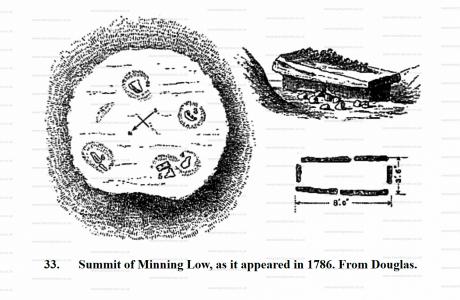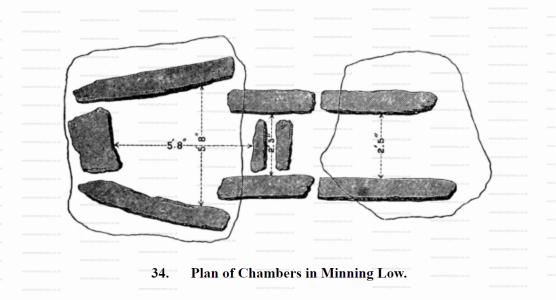Europe, British Isles, North-Central England, Derbyshire Dales, Hartington, Minning Low Chambered Tomb [Map]
Minning Low Chambered Tomb is in Hartington [Map], Peak District Neolithic Burials.
3400BC. Minning Low Chambered Tomb [Map] is one of the oldest prehistoric monuments in Derbyshire. It comprises five chambered tomb and two Round Barrows located on a highly prominent mound. Today, the mound has a crown of trees making it obvious even at great distances. When north of Minninglow it can be seen from twenty miles away from the Kinder Plateau on a clear day.
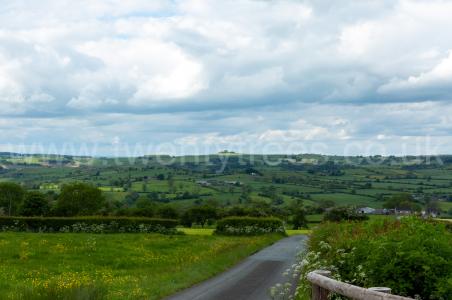
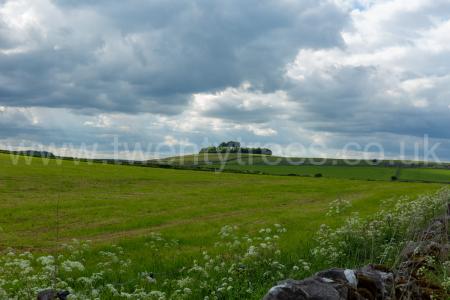

Nenia Britanica. Mining Low [Map] N° 2. Letter of Mr Rooke.
When I had last the pleasure of communicating to you a little account of the tumuli in Derbyshire, I had not then seen Mining Lowe [Map]; last summer I visited that very magnificent sepulchral monument, where on the top appeared five kistvaens; these were discovered some years ago in removing the earth and stones from the top, for making the walls which now inclose the plantation round the tumulus; the kistvaens had been all opened; and I was told that an iron sword, with the handle of one entire piece, was found in that marked (2) in the Plan. They vary in their positions; some stand nearly East and West; others North and south.
N° 2. A plan of the top of Mining Lowe, 81 feet diameter, with the situations of five kistvaens, (2.) (3.) (4.) (5.) (6.); (a) in N° 1. is a perspective view of the kistvaen marked (2.) in the plan, which stands nearly East and West; the top stone is nine feet by six; (B) is a ground plan of the same; length eight feet, width three feet fix inches, depth five feet eight inches; four unhewn stones form the sides, and two the ends; (c) the inside view of the kistvaen marked (S.) in the plan. The circumference of this lowe at the base is 1348 feet. This plan was taken in May, 1786.

Stephen Glover 1831. A large barrow [Wolfscote Hill Barrow [Map]] is to be seen on a high eminence called Wolfs-cote hill, in Hartington parish; and upon the common, which extends ten miles in the direction of north and south, are many barrows, generally situate on the highest points of ground. Near Brassington there is a remarkable low or barrow, called Mining low [Map], having a number of vaults carried round its circumference, several of them now exposed to sight. During the time of the enclosure, a quantity of human bones were found on the moor.
Section I Tumuli 1843. In a plantation on the summit of Minninglowe Hill [Map] are two tumuli of large size, one being near fifteen feet high from the level of the ground. In the centre and in four places in the area of the circle are large cists, or, as they now appear from the soil being removed from them, large cromlechs, exactly of the same construction as that well-known druidical structure "Kit's-Coty-House [Map]" near Maidstone, Kent. They are formed of the large limestones of the country and have all had covers of the same only two of which now remain in their places. The other tumulus is of smaller dimensions and contains but one cist which is in the centre; it is situated about thirty yards distance from the larger one. The soil in the interior of the cists of the large barrow was removed down to the surface of the rock on the 5th of July 1843 when it was found that all the interments had been before removed, with the exception of one which was a skeleton laid at full length on the outside of the cist, unaccompanied by any weapons or ornaments. In the cell near which this body lay were found fragments of five urns, some animal bones, and six third brass Roman coins, namely, one of Claudius Gothicus, two of Constantine the Great, two of Constantine Junior, and one of Valentinian. An attempt to penetrate the substance of the mound was then made, which from want of time proved ineffectual. A few human teeth and a third brass coin of Constantine were the only relics found in this part of the excavation; but a far more interesting discovery was made of the manner in which this huge tumulus was built, a wall being found to encircle it in a manner precisely similar to the walls built round some of the Etruscan tumuli discovered in the south of Italy. In one part of this wall, which was exposed by the excavation, a gallery formed of stones set up edgeways, with others across the top of them, was found to have its commencement. This was not explored, owing to the roofing-stones having fallen in in some places. There is a striking analogy between this tumulus and the great barrow at New Grange [Map], in Ireland, described by Dr. Ledwich, of which a more complete investigation of Minning Lowe would probably furnish additional proof. The following day was selected to be the time for extending the researches of the smaller barrow, the cist of which, as well as those of the larger one, was found to have been previously rifled of its treasures, a few human teeth being the only traces of the interment at this time found. Continuing the cutting through the entire mound, a simple deposit of burnt human bones was found, near one side, which had not been before disturbed.
Minninglow. 18th of July [1849] we made a slight excavation in the large barrow at Minninglow [Map], near the cist wherein a skeleton was found in 1843 (Vestiges, p. 39). The cutting was continued through loose stones to the depth of 4 feet from the surface, when the natural soil appeared, and through the whole we found many pieces of firmly baked Romano-British pottery that had been formed on the wheel, from clay mixed with coarse sand and small pebbles, which had acquired in baking colours varying from brick red to dark grey or purple; altogether we collected near a peck of fragments, which might have been purposely broken, as no large pieces are to be found amongst them; most of them appear to be parts of vessels modelled after the pattern of the common globular cinerary urn of the Romans. Near the natural soil we found two small brass coins in good preservation.
I. Constantino the Great. Reverse: Gloria Exercitus. Two figures holding standards.
II. Constantius II. Same legend and same reverse.
Minninglow. We spent the 13th of September [1851] in excavating at the large chambered barrow at Minninglow [Map], where we cleared out a very large and perfect megalithic chamber, on the south side, which had previously escaped a close examination at our hands, though it had evidently been explored before; as we found only one or two pieces of ancient human bone, and many animal bones of recent date. The plan shews the arrangement of the stones forming the chamber, with the interior dimensions, excepting the height, which is rather more than five feet; the largest capstone is about seven feet square.
There are several imperfect cists in the same barrow, and one of similar structure to the present, in the centre, which yet remains perfect, and is covered in by a capstone. At the west side of the mound we found two small brass coins of Constantino, jun., with the common reverse of two soldiers with standards - legend, GLORIA EXERCITVS, - which lay just below the turf, and numerous pieces of Romano-British pottery, which may be accounted for by the following extract from the MS. Diary of White Watson, F.L.S., of Bakewell, the friend and associate of many scientific men and antiquaries of the last century. Under a drawing of two urns similar to Roman ollæ in shape: - "1784, April 20th. Drawing of the fragments of two urns, found in a barrow at Minninglow, by Mi. C. Taylor, Stanton." "Time was, these ashes lived; A time must be. When others thus may stand And look on thee."
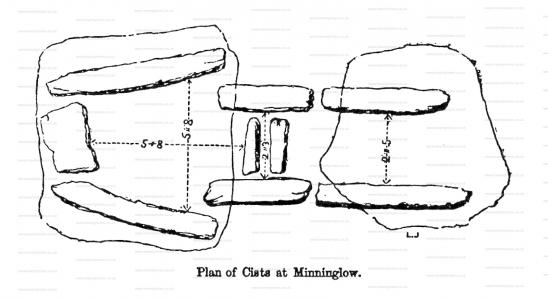
Llewellynn Jewitt 1870. At Minninglow [Map], in Derbyshire, erections of this kind occur, but, not being denuded of their mounds, are still partially buried. The mound is of large size. Under the centre and in four places in the area of the circle are large cists, which if cleared from the earth would be fine cromlechs of precisely the same form as those just described. They are formed of large slabs of the limestone of the district, placed upright on the ground, and are covered with immense capstones of the same material. All these chambers had contained interments. The accompanying plan (fig. 42) of some of these cists gives the situation of the stones forming the sides of the large chamber; of the passage leading to it; of the slabs which closed its entrance; and of the covers or capstones. The chamber is rather more than five feet in height, and the largest capstone about seven feet square, and of great thickness. A kind of wall similar to those which have been found to encircle some of the Etruscan tumuli, forms the circle of this mound, which rises to a height of more than fifteen feet from the surface of the ground1.
The general arrangement of this example will be seen to bear an analogy to the Plas Newydd [Map] and others spoken of, and shows by what an easy transition the building of galleries, or a series of chambers for family tombs, in these large mounds, would be arrived at. Of this kind some very large examples exist in Ireland, and in the Channel Islands, as well as in various parts of England.
Note 1. It is worthy of remark, that this noble mound, with its very early interments, has been made a place of sepulture in more recent times, many Roman coins and remains of that period having been found there.
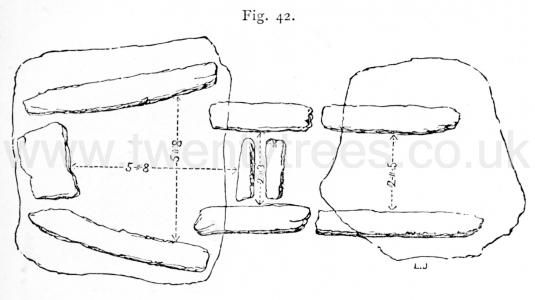
Rude Stone Monuments in all Countries Chapter IV. Be this as it may, if Mr. Bateman's suggestion that this monument is a counterpart of Kit's Cotty-house is correct—and no one who is familiar with the two monuments will probably dispute it—this at once removes any improbability from the argument that the last-named may be the grave of Catigren. The one striking difference between the two is, that Kit's Cotty-house is an external free-standing dolmen, while Minning Low [Map] is buried in a tumulus. This, according to the views adopted in these pages, from the experience of other monuments, would lead to the inference that the Kentish example was the more modern of the two. It is not, however, worth while arguing that point here; for our present purpose it is sufficient to know that both are post-Roman, and probably not far distant in date.
Rude Stone Monuments in all Countries Chapter IV. Though Gib Hill is interesting as the first of the high-level dolmens which we have met with in this country, Minning Low [Map] is a still more striking example of that class which we hinted at before as common in Aveyron (ante, woodcut No. 8), and which we shall meet with frequently as we proceed. When it first attracted the attention of antiquaries in 1786, Minning Low [Map] seems to have been a straight-lined truncated cone, about 300 feet in diameter, and the platform on its summit measured 80 feet across170. Its height could not be ascertained171. It was even then planted over with trees, so that these dimensions, except the breadth of the platform, are hardly to be depended upon, and since then the whole mound has been so dug into and ruined, that they cannot now be verified. On the platform at the top in 1786 there stood five kistvaens, each capable of containing-one body; and, so far as can be made out from Douglas' plates and descriptions, the cap stone of these was flush with the surface, or possibly, as at Gib Hill, they may have been a few inches below the surface, and, becoming exposed, may have been rifled as they were found; but this is hardly probable, because unless always exposed, it is not likely they would have been either looked for in such a situation, or found by accident. Below them—at what depth we are not told—a stone chamber, or rather three chambers, were found by Mr. Bateman, apparently on the level of the ground on the south side of the Barrow172. To use Mr. Bateman's own words ('Vestiges,' &c., p. 39): "On the summit of Minning Low Hill [Map], as they now appear from the soil being removed from them, are two large cromlechs, exactly of the same construction as the well-known Kit's Cotty-house, near Maidstone, in Kent. In the cell near which the body lay were found fragments of five urns, some animal bones, and six brass Roman coins, viz., one of Claudius Gothicus (270), two of Constantine the Great, two of Constantine, junior, and one of Valentinian. There is a striking analogy between this and the great Barrow at New Grange, described by Dr. Ledwich, of which a more complete investigation of Minning Low [Map] would probably furnish additional proofs." Mr. Bateman was not then aware that a coin of Valentinian had been found in the New Grange mound173, which is one similarity in addition.
Note 170. Douglas, 'Nenia Brittanica,' p. 168, pl. xxxv.
Note 171. If we knew its height we might guess its age. If it was 65 feet high, its angle must be 30 degrees, and its age probably the same as that of Silbury Hill. If 100 feet, and its angle above 40 degrees, it must have been older.
Note 172. 'Ten Years' Diggings,' p. 82.
Note 173. 'Petrie's Life,' by Stokes, p. 234.
